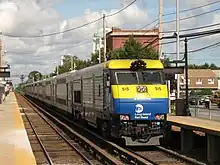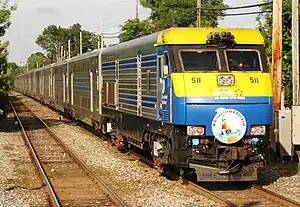EMD DE30AC and DM30AC
The EMD DE30AC and DM30AC are a class of 46 locomotives built between 1997–1999 by Electro-Motive Division in the Super Steel Plant in Schenectady, New York, for the Long Island Rail Road of the Metropolitan Transportation Authority (MTA) in New York. Originally divided equally between the two types, the fleet currently consists of 24 DE30AC locomotives (diesel power only) and 20 DM30AC locomotives (diesel or third rail power).
| EMD DE30AC/DM30AC | |||||||||||||||||||||||||||||||||||||||||||||||||||||||||||||||||||||||||||
|---|---|---|---|---|---|---|---|---|---|---|---|---|---|---|---|---|---|---|---|---|---|---|---|---|---|---|---|---|---|---|---|---|---|---|---|---|---|---|---|---|---|---|---|---|---|---|---|---|---|---|---|---|---|---|---|---|---|---|---|---|---|---|---|---|---|---|---|---|---|---|---|---|---|---|---|
.jpg.webp) DM30AC 501 at New Hyde Park | |||||||||||||||||||||||||||||||||||||||||||||||||||||||||||||||||||||||||||
| |||||||||||||||||||||||||||||||||||||||||||||||||||||||||||||||||||||||||||
| |||||||||||||||||||||||||||||||||||||||||||||||||||||||||||||||||||||||||||
| |||||||||||||||||||||||||||||||||||||||||||||||||||||||||||||||||||||||||||
| |||||||||||||||||||||||||||||||||||||||||||||||||||||||||||||||||||||||||||
| [2] | |||||||||||||||||||||||||||||||||||||||||||||||||||||||||||||||||||||||||||
Details
The DE30AC and DM30AC locomotives replaced aging GP38 locomotives, with GP38s used to push and pull diesel trains and other locomotives converted into power packs (cab control) used to provide head-end power for the trains. The bodies of the DE30AC and the DM30AC are extremely similar; the difference is the ability of the DM30AC to use electric third rail while the diesel engine is off, enabling the locomotive to use the East River Tunnels into New York Penn Station. This permits direct service from non-electrified lines in eastern Long Island via the western electrified main lines all the way to Penn Station. A few such trains a day run on the Port Jefferson, Montauk, and Oyster Bay branches, usually during peak times.
Single engines run with six cars or fewer, in which case the engine is on the east end of the train and a C3 cab car is on the west (Manhattan-facing) end. Generally, two engines are used when there are seven or more cars.
Accidents
- DM30AC 503 was damaged in an accident at Huntington on October 23, 2000, when a defective shoe beam caused a 750-volt short circuit with the locomotive's third rail contact shoe, which in turn caused the locomotive to catch fire.[4] It sat in the LIRR's Morris Park Facility and had been stripped for spare parts to maintain the remainder of the fleet until July 2018, when it was scrapped.
- DM30AC 511 was damaged in an accident on May 25, 2019. It hit a 14-unit long train stopped at the siding east of Speonk station, which is 13 units long; this caused the locomotive to lose a third rail shoe and sustain frame damage.[5] It is now sitting in the Morris Park Facility, most likely to be used for parts before being scrapped.[6]
In addition, DM30AC 507 suffered an electrical cabinet failure. Unlike 503 and 511, it was salvaged by being converted into a DE30AC locomotive, renumbered to 423, and returned to service.
Planned replacement
In December 2020, the Metropolitan Transportation Authority of New York board approved a Federal Transit Administration-funded $335 million contract for 27 dual-mode locomotives, based on the Siemens Charger design. The order also includes additional options for up to 144 more locomotives, of which 66 could go to the LIRR. The LIRR has not optioned the locomotives as of July 2023.[7][8]
Gallery
 DE30AC #401
DE30AC #401 DM30AC #515
DM30AC #515 DM30AC #511 on the Cannonball Express
DM30AC #511 on the Cannonball Express The cab of engine #513
The cab of engine #513 The remnants of engine #503 (August 2011)
The remnants of engine #503 (August 2011) The cab of engine #503 (August 2011)
The cab of engine #503 (August 2011)
See also
References
- "New 710ECO Repower Products Provide High Performance for Low and Medium Horsepower Applications" (PDF). Electro-Motive Diesel. March 2008. Archived from the original (PDF) on August 28, 2016.
- "Diesel-Electric Passenger Locomotives DE30AC and DM30AC" (PDF). Siemens AG. Retrieved January 14, 2011.
- LaMay, Robert A. (1998). "Long Island Rail Road's DE30 and DM30 Locomotives". Railpace. Archived from the original on June 23, 2018. Retrieved August 31, 2008.
- Demoretcky, Tom; Mason, Bill (October 24, 2000). "LIRR Fire Delays Port Jeff Branch". Newsday. p. A.28.
- Castillo, Alfonso A. (October 30, 2019). "Track circuit failure caused LIRR train derailment in Speonk, report states". Newsday. Retrieved August 4, 2023.
- "Long Island Railroad Wrecks". TrainsAreFun. 2006.
- "Joint Metro-North and Long Island Committees Meeting". Metropolitan Transportation Authority. December 2020. pp. 128–132.
- "Metro-North set to buy dual-mode locomotives from Siemens". Trains Magazine. December 14, 2020. Archived from the original on January 31, 2021. Retrieved February 1, 2021.
External links
 Media related to EMD DE30AC locomotives at Wikimedia Commons
Media related to EMD DE30AC locomotives at Wikimedia Commons Media related to EMD DM30AC locomotives at Wikimedia Commons
Media related to EMD DM30AC locomotives at Wikimedia Commons- EMD DE30AC/DM30AC Sell Sheet via Archive.org

